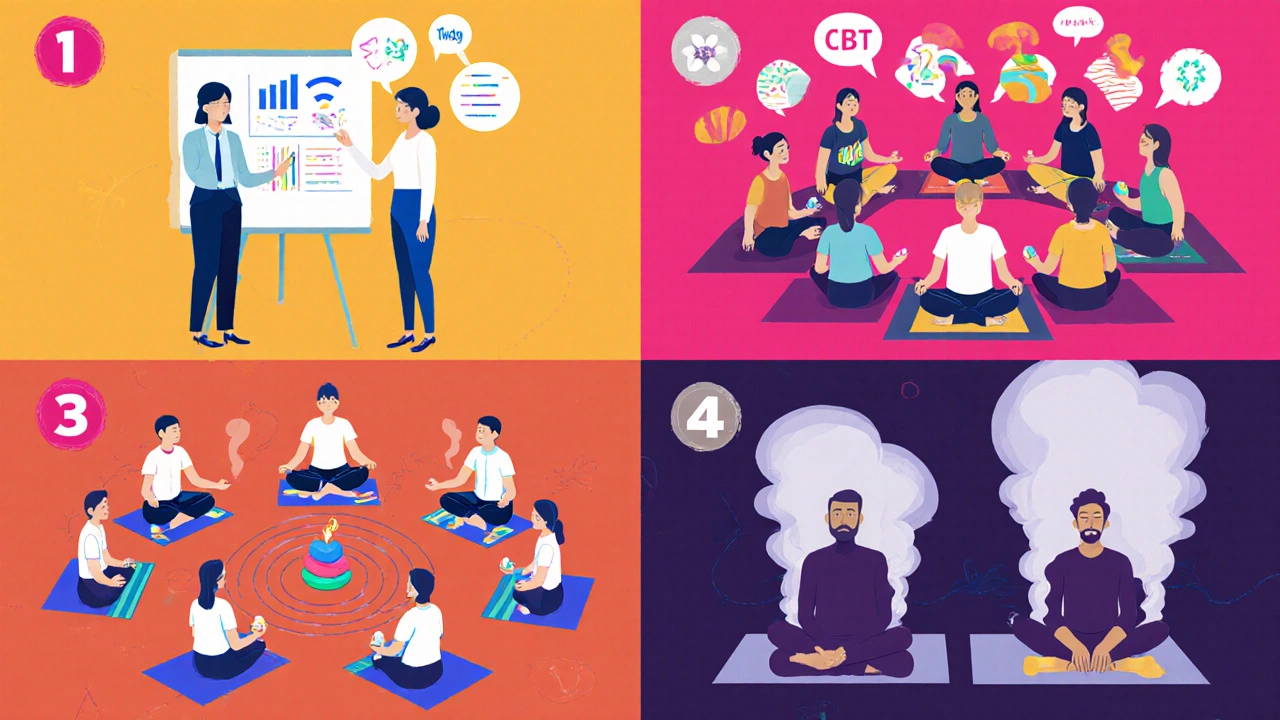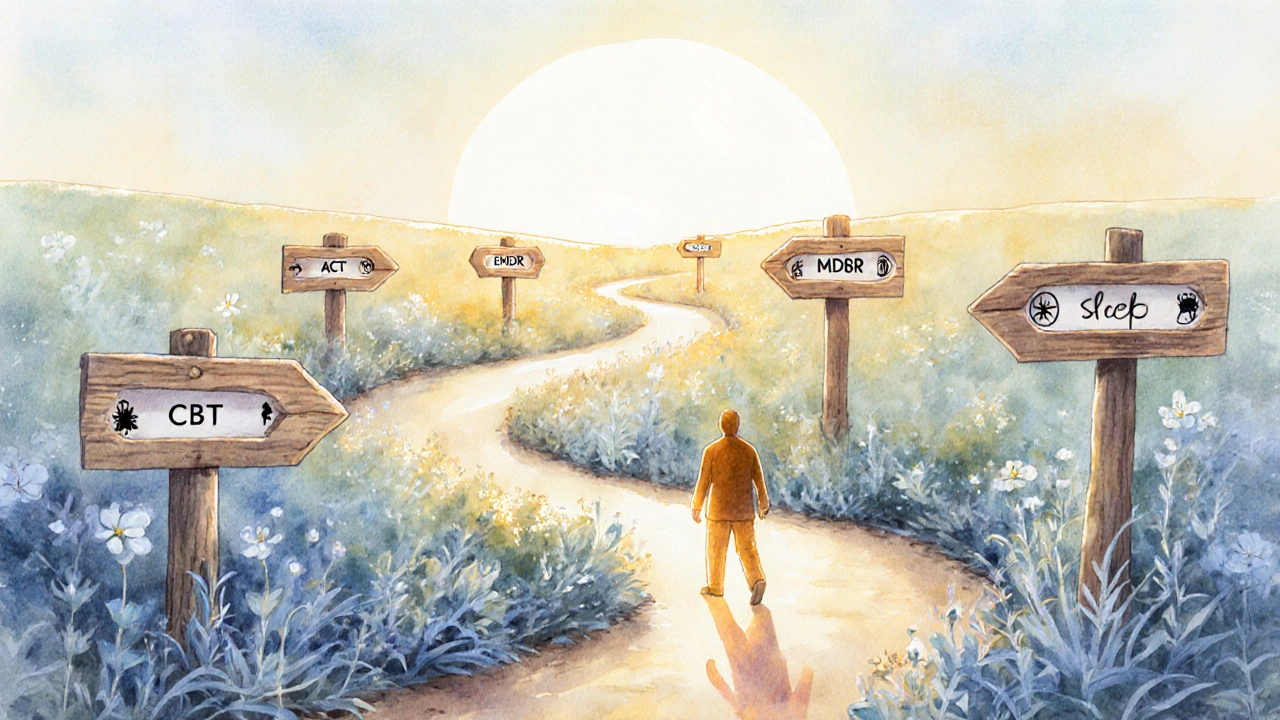Mental Health Therapy Finder
Answer a few questions to discover which therapy approach might be the best fit for you. This tool helps match your situation with evidence-based therapies described in our guide.
When you ask yourself, “What is the best therapy for mental health?”, the answer isn’t a one‑size‑fits‑all. Different approaches work better for different people, conditions, and life situations. Below you’ll find a clear roadmap that walks you through the major therapy families, how they compare, and practical steps to pick the right fit for your own journey.
Key Takeaways
- Therapy effectiveness hinges on the match between the method, the issue, and personal preferences.
- Cognitive Behavioral Therapy (CBT) remains the most evidence‑backed for anxiety and depression.
- Trauma‑focused therapies like EMDR and DBT excel for PTSD and emotional regulation.
- Mindfulness‑based approaches add a gentle, skills‑first angle for stress reduction.
- Choosing a therapist you trust is as crucial as the therapy model itself.
Understanding Mental Health Therapy
Mental health therapy is a structured, professional intervention that helps individuals manage emotional, cognitive, and behavioral challenges. It can be short‑term or long‑term, individual or group, and often blends talk‑based techniques with practical exercises. The ultimate goal is to improve coping, reduce distress, and foster lasting change.
Major Therapy Families
Below are the most widely practiced modalities, each with a distinctive focus and evidence base.
Cognitive Behavioral Therapy (CBT)
CBT centers on the idea that thoughts, feelings, and behaviors form a cycle. By identifying distorted thoughts and replacing them with realistic alternatives, clients learn to change emotional reactions and actions. Hundreds of randomized controlled trials (RCTs) show strong outcomes for depression, generalized anxiety, panic disorder, and even insomnia.
Dialectical Behavior Therapy (DBT)
Originally created for borderline personality disorder, DBT combines CBT skills with mindfulness and acceptance strategies. The core modules-mindfulness, distress tolerance, emotion regulation, and interpersonal effectiveness-make it a go‑to for emotional dysregulation, self‑harm, and eating‑disorder behaviors.
Psychodynamic Therapy
This approach explores unconscious patterns that stem from early life experiences. By bringing hidden conflicts into awareness, clients can resolve lingering emotional knots. It tends to be longer‑term (often 12-24 months) and works well for chronic depression, relationship issues, and personality traits.
Interpersonal Therapy (IPT)
IPT focuses on the link between current relationships and mood symptoms. Short‑term (12-16 weeks) and highly structured, it is effective for depression triggered by role transitions, grief, or interpersonal disputes.
Eye Movement Desensitization and Reprocessing (EMDR)
EMDR uses bilateral stimulation (eye movements, taps, or tones) while the client recalls traumatic memories. The process appears to re‑encode distressing memories, reducing vividness and emotional charge. It is the leading evidence‑based treatment for post‑traumatic stress disorder (PTSD).
Acceptance and Commitment Therapy (ACT)
ACT blends mindfulness with values‑driven action. Rather than battling unwanted thoughts, clients learn to accept them and commit to behaviors aligned with personal values. Research supports its use for anxiety, chronic pain, and substance‑use disorders.
Medication‑Assisted Therapy
While not a talk therapy per se, many clinicians combine psychotherapy with psychiatric medication (e.g., SSRIs for depression, anxiolytics for acute anxiety). The synergy often speeds symptom relief and enhances the effectiveness of psychotherapeutic work.
Mindfulness‑Based Stress Reduction (MBSR)
MBSR teaches systematic meditation, body scans, and gentle yoga. It cultivates present‑moment awareness, which lowers cortisol, improves sleep, and boosts emotional resilience. It is a solid adjunct for chronic stress, burnout, and mild mood disturbances.

How to Choose the Right Therapy for You
Picking the "best" therapy is a blend of evidence, personal fit, and practical considerations. Use the following checklist:
- Identify the primary issue. Anxiety, depression, trauma, relationship conflict, or chronic pain each have a therapy with the strongest research backing.
- Consider treatment length. If you need quick relief (weeks), CBT, IPT, or EMDR are ideal. For deeper personality work, psychodynamic or DBT may be better.
- Assess your comfort with emotional exposure. Trauma‑focused therapies require confronting painful memories; if that feels overwhelming, start with mindfulness‑based or ACT approaches.
- Check therapist credentials. Look for certifications (e.g., CBT‑certified, EMDR‑approved) and years of experience with your specific condition.
- Factor in logistics. In‑person vs. telehealth, session cost, and insurance coverage can sway decision.
Once you have a shortlist, schedule a brief consultation (often free) to gauge rapport. The therapeutic alliance-how safe and understood you feel-predicts outcomes more than any specific model.
Therapy Comparison Table
| Therapy | Primary Targets | Typical Duration | Evidence Strength | Best For |
|---|---|---|---|---|
| CBT | Negative thoughts, maladaptive behaviors | 8‑20 weekly sessions | High (multiple RCTs) | Anxiety, depression, insomnia |
| DBT | Emotion regulation, self‑harm | 6‑12 months (weekly + skills groups) | Strong (borderline PD, crisis) | Emotion dysregulation, eating disorders |
| EMDR | Trauma memories | 6‑12 sessions (intensive) | Very strong for PTSD | Post‑traumatic stress, phobias |
| ACT | Thought acceptance, values‑based action | 8‑16 sessions | Growing (anxiety, chronic pain) | Stress, chronic illness, addiction |
| MBSR | Stress, mindfulness | 8 weekly group sessions + home practice | Moderate (stress, burnout) | Workplace stress, sleep issues |
Practical Steps to Get Started
- Research local providers. Use directories, ask your primary doctor, or check professional bodies like the American Psychological Association.
- Verify credentials. Look for licensure (e.g., LPC, LCSW, PsyD) and specialty certifications.
- Ask about the therapy model. A good therapist will explain their approach and why it fits your issue.
- Discuss logistics early. Confirm session length, cost, cancellation policy, and telehealth options.
- Commit to practice. Most therapies include homework-journaling, exposure exercises, or mindfulness drills. Consistency amplifies results.

Common Myths & Pitfalls
Myth 1: "Therapy is only for severe mental illness." In reality, anyone dealing with persistent stress, relationship tension, or life transitions can benefit.
Myth 2: "One session will solve everything." While a single insightful conversation can spark change, lasting improvement usually requires regular work.
Pitfall: Ignoring the therapeutic alliance. Even the most evidence‑based model falters if you don’t feel heard. Trust your gut-if the connection feels off, try another therapist.
Conclusion
There isn’t a universal "best" therapy for mental health; the optimal choice aligns the evidence base, your personal preferences, and practical realities. By understanding the core differences among CBT, DBT, EMDR, ACT, and other approaches, you can make an informed decision and start a path toward lasting wellbeing.
Frequently Asked Questions
How long does therapy usually last?
Duration varies by model: CBT often 8‑20 weeks, DBT 6‑12 months, EMDR 6‑12 intensive sessions, while psychodynamic work can span years.
Can I combine medication with therapy?
Yes. Medication‑assisted therapy is common; meds can reduce symptoms enough for psychotherapy to be more effective.
Is telehealth as effective as in‑person sessions?
Research shows teletherapy outcomes comparable to face‑to‑face care for most modalities, especially CBT and ACT.
What if I don’t feel better after a few weeks?
Therapy isn’t instant; give it 8‑12 sessions to see trends. If progress stalls, discuss adjustments with your therapist or consider a different modality.
Do I need a diagnosis to start therapy?
No. Many providers accept self‑referrals for issues like stress, grief, or relationship problems without a formal psychiatric diagnosis.







